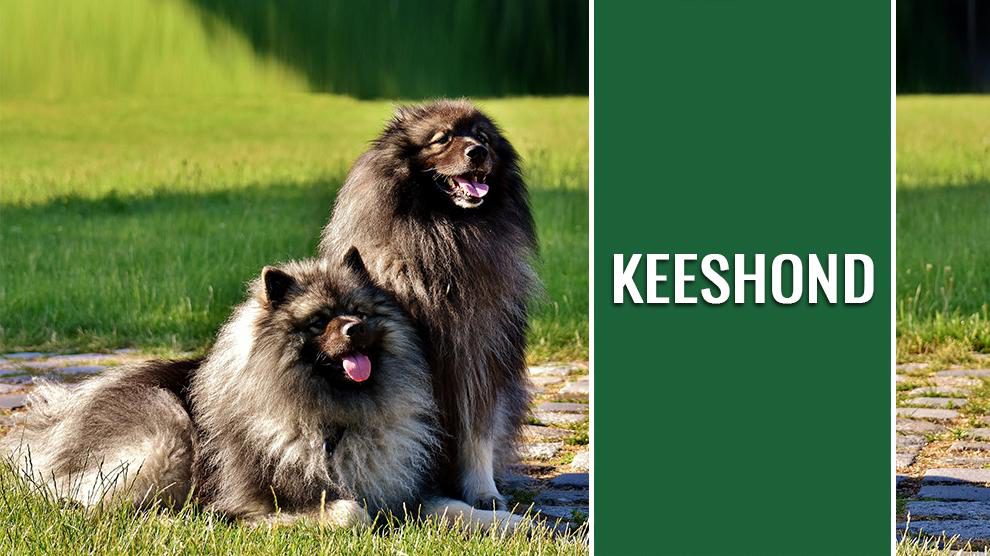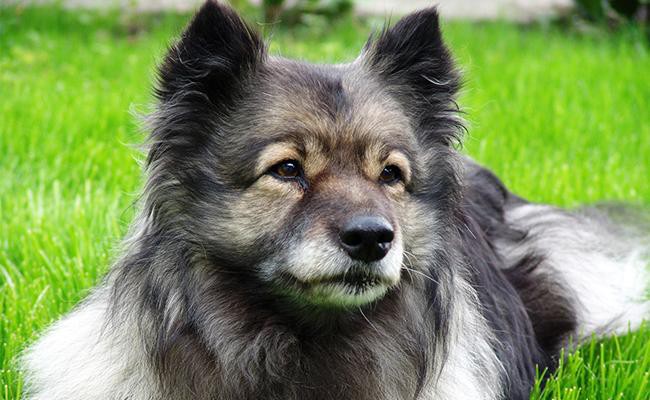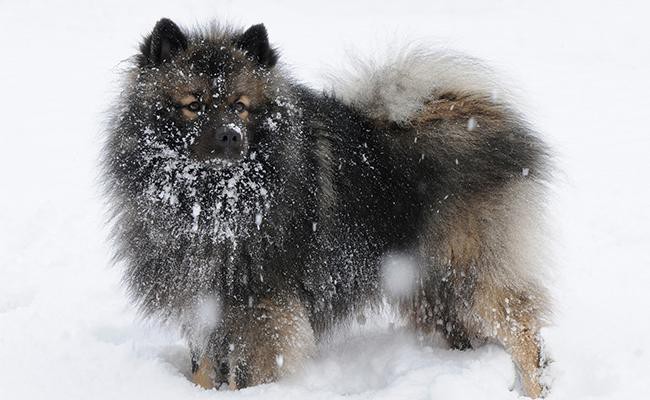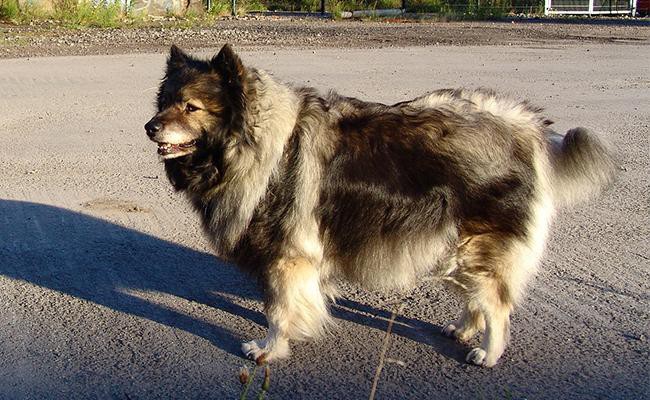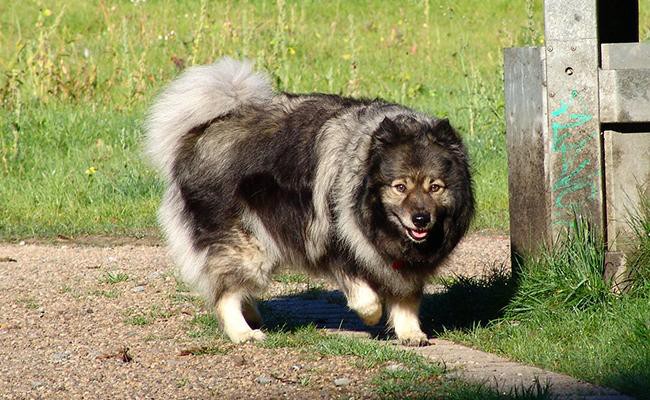Dog Pregnancy Calculator And Timeline
Keeshond is a medium-sized Spitz-Nordic family dog and this is the most humble people-loving-pooch you could ever hope to find.
The Keeshond is known lovingly by many names. It is also called as Dutch Barge Dog, Chien Loup, Deutscher Wolfspitz, “The Smiling Dutchman”- due to the way it twists its lips and bares its teeth, “fox dog”- due to the wedge-shaped head and foxy expression; and “Overweight Pomeranian” – perhaps due to its lion-like mane around the neck led to the name.
The expressive markings and shadings around the Keeshond’s eyes is a distinguishing characteristic that resembles eyeglasses gives it an intelligent and inquisitive expression.
Bred to guard barges, they have moderate exercise needs than you’d expect, and they are happiest just being with you.
The bespectacled Keeshond is a happy-go-lucky dog. More than earning the moniker “Velcro dog,” he is a vivacious, cordial, and friendly dog who is ultimately affectionate with its household.
How To Pronounce Keeshond?
Keeshond is pronounced as “keyz-hawnd” and the plural is “Keeshonden”. This breed can be a good choice for families with kids and generally gets along well with other animals, especially if it is raised with them.
Keeshond Breed Characteristics
- Origin: Holland
- Size: Small
- Dog Breed Group: Non-Sporting(Akc, Ckc), Group 5 (Fci), Utility(Kc), Northern Breed( Ukc)
- Purebred: Yes
- Lifespan: 12-14 Years
- Height: Male:17-19 Inches (44 – 48 Cm), Female: 16-18 Inches (40 – 46 Cm)
- Weight: Males: 15 – 20 Kg (35-45 Lbs) And Females: 15 – 20 Kg (35-45 Lbs)
- Coat Appearance: Thick Double Coat
- Coat Colors: Grey, Silver Grey, Silver, Grey, And Black
- Temperament: Alert, Athletic, Affectionate, Easygoing, Dedicated, Hard Working, Intelligent, Loyal, Keen, Vigilant
- Good With Children: Yes
- Intelligence Level: High
- Good With Pets: Yes
- Hypoallergenic: No
- Grooming: High
- Shedding: High
- Barking: Yes
- Suitable For Apartments: Yes
- Need For Exercise: High
- Easy To Train: Yes
- Good For First Time Owners: Yes
- Health Issues: Hip Dysplasia, Renal Cortical Hypoplasia, Patellar Luxation
- Litter Size: 4- 6 Puppies
- Average Price: $ 800 – $1000 Usd (USA), £900 For Kc Registered Dogs, £400 For Non-Kc Registered Dogs
Keeshond Dog Breed History
These energetic dogs have a long and very interesting political past. Historically, the origin of the name Keeshond is still a matter of speculation.
These nimble-footed dogs were employed as watchdogs on riverboats/barges that floated in the artificial waterways of the Low Countries.
These dogs lived on board as zealous guardians of their owners’ properties and playmates for their children. From ancient times, they were extensively used as canine sentries in most barges, farms, and carts.
They were called in France as “Chiens Loup”; in Germany as “Wolfspitzen” and in Italy as “Lupini”.
Holland was divided into two political factions in the late 1700s: the Orangists who supported the Prince of Orange as Governor of the Netherlands, and patriots, who opposed the Prince.
The patriot leader, Cornelius de Gyselaer, who was a leader in the patriot’s revolt, had one of these popular dogs as his constant companion.
The Keeshond symbolized the rebels and it seems significant in regard to a basis for the breed’s name that “Kees” de Gyselaar’s “hond” became the symbol of the Dutch party.
When the prince overthrew the patriot’s rebellion, many Keeshonds lost their political significance and were destroyed for fear that possession of the dogs would signify association with the defeated rebels.
Hence, this popular breed ironically became the casualty of its own fame.
Though some farmers and barge captains retained the dogs and kept unofficial stud records for their own use, it took more than a century for the Keeshond to emerge from the hiatus.
The breed again suffered during both the world wars due to a lack of available food and was greatly reduced in numbers. Since then, it has gradually gained popularity due to its exceptional qualities as a sensible, all-around great family dog.
The first official Dutch club was formed in 1925 and it was renamed The Keeshond Club in 1926.
The American Kennel Club registered the first Keeshond in 1930 under the name “Keeshonden,” in the Non-Sporting Group. The Keeshond Club of America was formed in 1935.
Keeshond Appearance
Coat Color
- Grey
- Silver grey
- Silver, grey and black
The breed colors that are accepted for Kennel Club registration can vary from those mentioned in the different breed standards. All shades of grey are acceptable in almost all breed standards with body hairs having black tips.
What Is A Keeshond?
The Keeshond is a medium-sized Spitz-type dog that presents itself very confidently.
They have a strong resemblance to their ancestor, the Samoyed and they are also closest relatives of the German spitzes such as the Kleinspitz or Pomeranian and Mittelspitz.
Formerly called the Wolfspitz, the name was officially changed in 1926 to Keeshond.
There is quite an obvious difference between males and females as the former being a little heavier and bigger in stature than their female counterparts.
They have well proportioned, wedge-shaped heads that are nicely in proportion with the rest of their bodies.
They have a definite stop, dark muzzles equivalent to the length of the flat skull.
They have black noses and medium-sized, almond-shaped eyes set obliquely in the dog’s face.
Their ears are dark, small ivy-leafed in shape which they hold upright and are velvety in texture.
The well-muscled back legs, straight with a lot of lighter colored hair on them give the impression that they are wearing light-colored trousers.
They have cream-colored, well-padded cat-like feet having strong black nails.
Their moderately long tails are set high with dogs curling them firmly over their backs in a double curl.
How Big Do Keeshonds Get?
The average height of the male Keeshond ranges from 17 to 19 inches and the females from 16 to 18 inches.
The weight of an average healthy male dog is between 35-45 lbs and the females between 35-45 lbs.
Keeshond Lifespan
The average Keeshond dog lifespan is about 12-14 years sometimes as long as up to 15 years when properly cared for and fed a good quality diet to suit their ages.
What Is The Personality Of A Keeshond Dog?
A medium-sized spitz dog with a big personality, they are usually outgoing and lighthearted with their own family but tend to be wary of strangers.
Together with their alert nature, their natural prudence can make them exceptional watchdogs, although they are typically not aggressive towards people.
They are the best choice for families with kids. They do tolerate being handled roughly or teased by small kids.
In the right home, however, with suitable supervision, he can generally be a good companion for all ages.
These ‘smiling dutchies’ make great stereotypical Emotional Support Animals. They are friendly, gentle, and obedient.
Due to their laid-back nature, they adapt well to a variety of habitats ranging from small apartments to large homes.
They are also up for any adventure, if needed, whether it’s camping or hitchhiking. Their amusing personality and goofy antics will make you smile no matter how traumatic your day has been.
They are very sharp dogs and don’t miss anything. They usually recognize your “getting ready to exit” routines. They have also a very dependable off-leash nature and never stray far enough.
Do Keeshonds Bark A Lot?
These intelligent and inquisitive little dogs have one downside. Keeshonds are big barkers. Don’t get misled by their appearance.
They have the high-pitched yap of a Pomeranian; add with that the volume of a 40 lb dog.
The result is ear-drum shattering bark that is sure to elicit complaints from the neighbors. However, you can certainly train your Kees when they are, and are not, acceptable to bark.
They are generally quiet, but they also love to romp around in your backyard or garden.
Can Keeshond Swim?
These “Jack-of-all-trade” dogs were used in the past as watchdogs on riverboats/barges that floated in the artificial dugouts of the Low Countries.
They even guided the barges by swimming in front through foggy waters and led them. So, we can be sure that these skilled fix-its can swim too.
Keeshond Food
These are favorite foods that should be fed to Keeshond dogs:
- Boiled chicken
- Wild omega-rich fish
- Lean beef
- Sweet potatoes
- Brown rice
- Papaya
- Cantaloupe
- Spinach and broccoli
- Lettuce and carrot
- Bread dough and salty food
Best food for Keeshond puppies
- Wellness Complete Health Small Breed Puppy
- BLUE Life Protection Formula Puppy Small Breed Chicken and Oatmeal Dry Dog Food
- Diamond Naturals Small Breed Puppy Real Meat Recipe Natural Dry Dog Food
- Bil Jac Small Breed Puppy Dry Dog Food
- Tuffy’s NutriSource Chicken and Rice Formula Breed Dry Puppy Food
Best dry dog food for Keeshonds
- Wellness Core Natural Grain-Free Dry Dog Food
- Blue Buffalo’s Blue Life Protection Formula Adult Dry Dog Food
- Holistic Select Natural Grain-Free Dry Dog Food
- Natural Balance Limited Ingredient Diets Dry Dog Food
When Keeshonds don’t do well on beef or chicken-based diet for some reason, then feed them lamb meal-based dry kibble a try.
Best wet food for Keeshond Puppies
- Wellness Complete Health “Just for Puppy” Natural Wet Canned Dog Food
- Hill’s Science Diet Wet Dog Food Puppy
- NUTRO Ultra Puppy Wet Dog Food
Keeshond Training
Keeshonds can be a fantastic breed for experienced owners. Training can be a little difficult but not so tough. They’re also so sharp and they get into everything!
Those who are interested in this breed should do their homework and first-time owners should talk to breeders and other experienced owners before getting one.
Keeping the Keeshonds in shape won’t take much of your time and energy, as they don’t need much exercise.
Keeshonds tend to be of above-average intelligence, extremely reliable, and responsive dogs by nature. However, they do not respond well to any sort of heavy-handed training methods or bullying tactics.
They have high energy reserves and love some downtime as well. So don’t plan a vigorous exercise regime.
How To Train A Keeshond Puppy?
Kees is a good choice for first-time dog owners because they are easily trainable dogs.
These dogs are very eager to please and respond well to positive reinforcement techniques.
They thrive on being in a home environment.
However, start training at an early age as they’re non-resistive and people-oriented. This makes them easier to train than many other Spitz-type dogs and other canines in general.
They often need a trip to the local dog park or a game of fetch or a walk or jog around the neighborhood to feel satisfied.
They do respond well to positive reinforcement provided that their training is consistent and even-handed.
When Keeshonds are improperly socialized or left alone too much, they can get separation anxiety. Proper socialization of your Dog will help ensure that your dog has a happy, healthy life.
Keeshond Grooming
They have a plush double coat that works to keep them warm in the frosty climates of Nordic countries.
While they have harsh, straight waterproof outer coats, their inner coats are very soft and dense.
They have thicker hair growing in front of their legs and the backs of their thighs. They have a profuse ruff of thicker fur around their necks too.
Do Keeshonds Shed?
They shed copiously year-round and particularly during spring and fall season. Daily brushing will help keep hair under control during shedding seasons.
How To Groom A Keeshond?
For the cottony puppy coat, you can use a soft slicker brush. A stainless steel Greyhound comb or pin brush can also be used for rough coats.
Using the soft side of a pin brush, you can apply a little corn starch and then brush it out. This will whiten the coat and counteract any obnoxious smell she picked up in the shoulder rolling in the dirt.
Like any other dog, cleaning teeth, nail clipping, checking the ear should be done regularly.
Caring makes this ‘Smiling Dutchman’ smile always.
Keeshond Grooming Tips
Keeshonds grooming should be well planned and be prepared to brush your dog at least twice a week, though many owners recommend you to do it daily it is not really necessary
Care should be taken to groom the hair long all over the body, shorter hair on the legs, and markings on the coat should be penalized.
Keeshond Grooming Tools
- Using a wide teeth comb and a soft pin-brush, regular brushing should be done to keep the coat clean and tangle-free. If possible, use the slicker brush carefully to open up any tangles, but it must be done with great caution.
- Together with coat care, the ears should be regularly examined for any accumulation of dirt and earwax.
- Excess hairs in the ear canal should be pulled out with specially designed tweezers. Use a cotton disc lightly soaked in with cleansing milk and cleans the outer part of the ear.
- You can try the quality dog eye-cleansing products on the market with which eyes should be kept clean and tear stains should be cleaned off.
Keeshond Health Problems
Hip Dysplasia:
Hip dysplasia is one of the most common skeletal disorders seen in dogs. This is a multipart, multifactorial, polygenic developmental disorder distinguished by degenerative joint disease (DJD), coxofemoral (hip) joint laxity, osteoarthritis (OA), etc.
Hip dysplasia is usually caused by the combination of genes from the parents. When the hips are developing during the first few months of life, they become unstable.
Consequently, the femoral head (the ball) and the concave indentation of the pelvis- acetabulum (socket) will move apart unable to bear the weight.
This causes irregular forces on the soft bones which lead to the socket becoming shallow and the ball becoming flattened.
This is a self-perpetuating process and causes damage to the articular cartilage (covering of the bones). The key signs are lameness of hind limbs and stiffness.
There are different types of hip dysplasia depending on the extent to which hip is affected.
Renal cortical hypoplasia:
This condition can affect animals unilaterally or bilaterally.
Animals that are affected unilaterally have a poor prognosis, with treatment aimed at managing the subsequent renal failure while for animals affected bilaterally the prognosis is often serious, with death occurring soon after birth.
This defect has been reported in many breeds and this is an inherited condition in which the renal cortex (the largest part of the kidney that controls toxin and waste removal) has not developed properly.
Patellar luxation:
Patellar luxation is a common congenital/developmental musculoskeletal disorder in dogs and one of the most common causes of lameness in the dog.
This could also result as secondary to a traumatic accident causing stretching or tearing of the joint capsule and fascia, leading to femoropatellar instability.
Luxating patella simply means that the kneecap (patella) is dislocated from its normal anatomic position in the groove of the femur (thigh bone) and it is no longer able to slide across this groove.
Patellar luxation can be classified as medial, lateral, or bidirectional. This just indicates the direction in which the kneecap may be sliding.
Medial luxation is more prevalent than lateral luxation and it is commonly diagnosed in small breeds.
The less prevalent Lateral luxation is commonly diagnosed in large or giant breed dogs.
So, if a dog’s patella does not stay in its normal position in the groove and it is sliding on the inner aspect of the knee then this is considered a medial luxation patella and when the dislocated kneecap moves away from the femoral groove when the knee is flexed, it is lateral luxation.
Keeshond Names
Keeshond Puppy Names
- Apollo
- Bruin
- Blackhawk
- Caspar
- Edward
- Einar
- Frans
- Kaiser
- Nitro
- Tikva
Keeshond Names – Female
- Amara
- Anniken
- Elin
- Hella
- Jinx
- Maggie
- Natasha
- Roxy
- Stacy
- Rachel
Keeshond Price
The price of puppies will be $1000- $2500 from a reputable breeder. Keep in mind that there are also extras like vaccines, licenses, preventative medicine, heartworm testing, and – if needed spaying or neutering. Just add an extra $500 to the actual price.
Keeshond Breeders
You can check our most reputable Keeshond breeders in the USA

